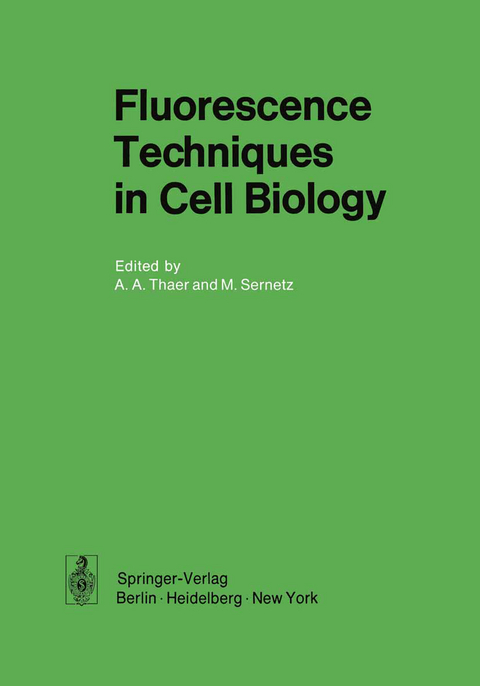
Fluorescence Techniques in Cell Biology
Springer Berlin (Verlag)
978-3-642-49206-8 (ISBN)
Opening Remarks.- I Introductory Papers.- Polarized Fluorescence.- Techniques for Fluorescence Lifetime Measurements and Time-Resolved Emission Spectroscopy.- II Instrumentation and Standardization in Fluorometry and Microscope Fluorometry.- Some Aspects of Instrumentation and Methods as Applied to Fluorometry at the Micro-scale.- Microcapillary Fluorometry and Standardization for Microscope Fluorometry.- The Use of Human Leukocytes as a Standard for the Cytofluorometric Determination of Protein and DNA.- A Microspectrofluorometer for Measuring Spectra of Excitation, Emission and Absorption in Cells and Tissues.- III Cytofluorometric Determination of Cellular Substances.- Absorbance and Fluorescence Cytophotometry of Nuclear Feulgen DNA. A Comparative Study.- Automation of Cytofluorometry by Use of the Impulsmicrophotometer.- Quantitative Determination of DNA and Protein in Single Cells.- Fluorescence Properties of the Monoaminoacridines and Some 2-Aminoacridine-Derivatives.- Fluorometric Recognition of Chromosomes and Chromosome Regions.- Chemical Aspects of the Fluorescence Analysis of Chromosomes.- Fluorescence Cytochemical Studies of Chromosomes: Quantitative Applications of Fluorescein Mercuric Acetate.- Microfluorimetric Comparison of Chromatin During Cytodifferentiation.- Immunofluorometric Determinations of Surface Immunoglobulins of Individual Normal and Malignant Human Lymphoid Cells.- Cytofluorometry of Biogenic Monoamines in the Falck-Hillarp Method. Structural Identification by Spectral Analysis.- Microfluorimetric Quantitation of Biogenic Monoamines.- Quantitation of Biogenic Monoamines Demonstrated with the Formaldehyde Fluorescence Method.- The Identification of Arylethylamines by Microspectrofluorometry of Acid- and Aldehyde-Induced Fluorescence.- IV Investigation of Enzyme Reactions and Transport Mechanisms.- Quantitative Aspects of Rapid Microfluorometry for the Study of Enzyme Reactions and Transport Mechanisms in Single Living Cells.- Rapid Microfluorometry for Biochemistry of the Living Cell in Correlation with Cytomorphology and Transport Phenomena.- Newer Fluorometric Methods for the Analysis of Biologically Important Compounds.- Microfluorometry Investigations on the Intracellular Turnover of Fluorogenic Substrates.- Changes in the Membrane Permeability of Human Leukocytes Measured by Fluorochromasia in a Rapid Flow Fluorometer.- V Fluorescent Molecular Probes for Complex Biological Molecules.- Probes for Enzyme Conformation.- The Fluorescence of Bilirubin-Albumin Complexes.- The Effect of the Excitation Wavelength on the Fluorescence Depolarization of Protein-Dye Complexes or Conjugates.- Fluorescence, Absorption, and Optical Rotatory Behavior of Acridine Orange: Poly-L-Glutamic Acid Complexes.- Ethidium Bromide: A Fluorescent Probe of Nucleic Acid Structure and its Potential for in-vivo Studies.- Nanosecond Fluorescence Spectroscopy of Biological Macromolecules and Membranes.- Measurements of Single Molecules of Antibody by Their Ability to Activate a Defective Enzyme.- Nanosecond Time-Resolved Fluorescence Spectroscopy in Molecular Biology.- Fluorescence Spectroscopy as a Tool for Studying Drug Interactions with Biological Systems.- Temperature Sensitivity of Fluorescent Probes in the Presence of Model Membranes and Mitochondria.- Conformational Dynamics of Model Membranes.- Atebrin and Related Fluorochromes as Quantitative Probes of Membrane Energization.- Fluorescent Molecular Probes in Fluorescence Microspectrophotometry and Microspectropolarimetry.- List of Attendees.
| Erscheint lt. Verlag | 9.4.2012 |
|---|---|
| Zusatzinfo | VIII, 420 p. 80 illus. |
| Verlagsort | Berlin |
| Sprache | englisch |
| Maße | 178 x 254 mm |
| Gewicht | 817 g |
| Themenwelt | Medizin / Pharmazie |
| Naturwissenschaften ► Biologie ► Mikrobiologie / Immunologie | |
| Naturwissenschaften ► Biologie ► Zellbiologie | |
| Schlagworte | biochemistry • Cell • Cell Biology • fluorescence • Fluoreszenzanalyse • Zelle |
| ISBN-10 | 3-642-49206-1 / 3642492061 |
| ISBN-13 | 978-3-642-49206-8 / 9783642492068 |
| Zustand | Neuware |
| Informationen gemäß Produktsicherheitsverordnung (GPSR) | |
| Haben Sie eine Frage zum Produkt? |
aus dem Bereich


